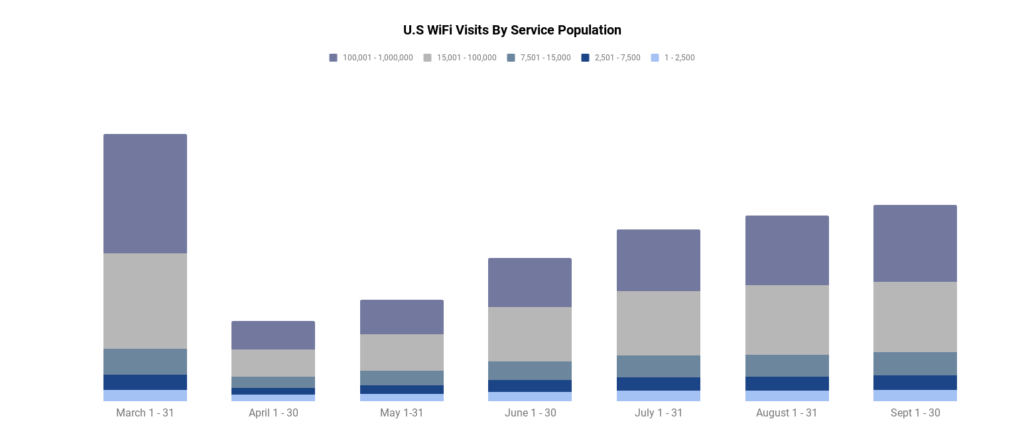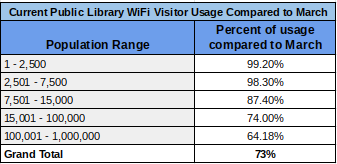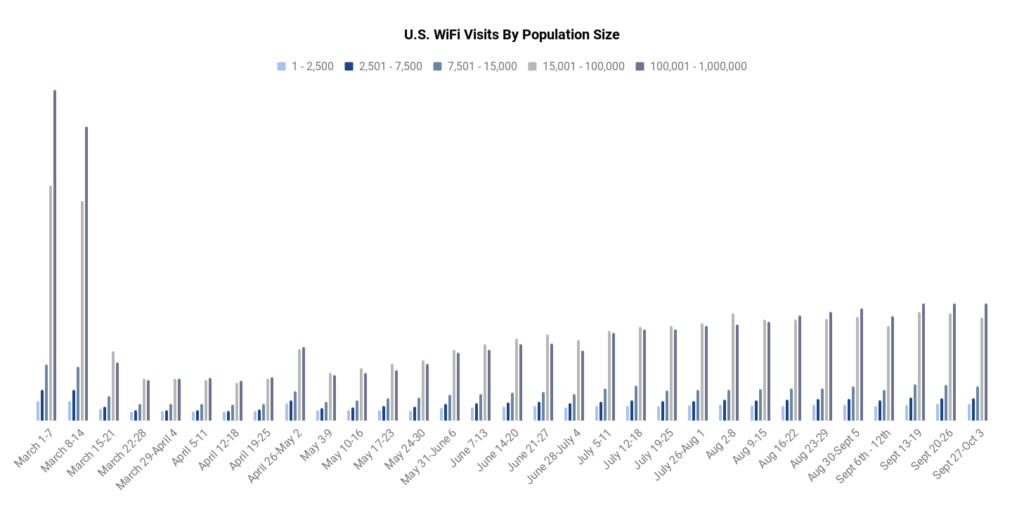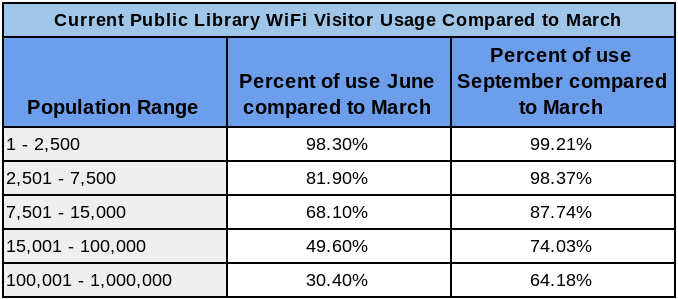Q3 Effects of COVID-19 on Public Library WiFi Use
WhoFi analyzed data from our library partners to determine the effect of COVID-19 on patron WiFi usage. This report includes our findings during Q3.
We’re now seven months into the COVID pandemic, and public libraries continue to adapt to this new normal by reinventing their services to meet the current needs of their communities. These new innovations are taking place across the country. Libraries are bolstering their online collections and expanding access, enhancing access to public WiFi, making it easier to get a library card, starting and adding to their virtual programming, adding outdoor programming, offering curbside pick-up, and curated book bags, to name a few.
This new reality created an environment for public libraries to rethink and improve how they serve communities. In many cases, libraries have migrated their in-person programming to the digital space. The flexibility of online programming is helping libraries reach additional community members. For some programs, this has resulted in increased attendance since patrons can attend storytime or participate in a seminar at their convenience and without concern for building capacity.
Many library buildings have reopened, but are operating at a limited capacity in accordance with safety guidelines. Services like grab-and-go, limited computer use, and printing/scanning/faxing are available inside the building, while other programming and outreach remain online. Libraries are providing more online resources (e-books, e-magazines, database access), virtual programming (storytime, craft sessions, etc), and WiFi access. In our library partners’ opinions, these services will continue in the future even after COVID. New demands such as video conferencing and e-learning make having high-speed internet vital to meet the changing needs of both the library and the community it serves.
As the new school year begins and many students are attending online classes, how has COVID affected library WiFi use in Q3?
Our data shows that after the initial drop in WiFi usage in March, trends steadied and then began to rise around April 26. In fact, there continues to be a steady increase in WiFi usage nationwide across cities and towns of all population sizes. Library efforts to enhance and extend WiFi services, paired with a solid communication plan, seem to have the desired effect of helping patrons stay connected. The total number of visits, however, isn’t as high as it was prior to shut-downs, but shows continued use despite building closures. The graph below shows WiFi usage trends from March through September.
The national WiFi usage rates were down 70% in April from the average of previous months usage rates. This has been the biggest recorded drop in WiFi use during the pandemic. By the end of June, the national WiFi usage rates had increased 40%, and have had another 35% increase from June to September. As you can see in the graph above, while there continues to be a steady climb in WiFi usage, the overall usage is still lower than it was in March. At the end of Q3, national WiFi usage in public libraries is now at 73% of what it was in March. A steady climb in usage is indicative of the community need while more people are working and going to school remotely.
Patrons in rural service areas often rely on the public library as their main source of internet. How can libraries improve the patron experience by improving digital services?
In our first report, we analyzed data by comparing urban and rural service areas to determine if there was a difference in WiFi usage across the population sizes. Our data showed that rural service areas have a higher percentage of the population that uses the library WiFi and showed more stable usage patterns since March. Why do patrons in rural service areas use the library WiFi more than those in urban areas? There’s a variety of cultural, social, and economic factors that contribute to this gap in internet access.
Public libraries are already considered an anchor institution that provides the internet to the community. How can libraries use their WiFi insights to advocate for enriched services? By using data to support stories. The FCC’s E-Rate funding is one solution to help bridge the gap. The IMLS is distributing $30 million in funding to libraries across the U.S. as part of the CARES Act in response to the impact of COVID-19. States will be able to use the funds to expand digital network access, purchase internet accessible devices, and provide technical support services to citizens to address digital inclusion efforts. Rural schools and libraries may also receive more funds to get the internet. The graph below shows the more stable WiFi usage rates of rural population areas compared to urban counterparts.
Breakdown of WiFi usage rates by service population size.
The graph above shows the WiFi usage rates of each population size from March to September. The most drastic change in usage rates was in the 100,000-1,000,000 population size group, which has only regained about two-thirds of its previous WiFi usage rates. Another interesting metric is the 1-2,500 and 2,500 -7,500 population size groups, which both have now regained nearly all of their previous WiFi usage rates. Smaller population areas have also recovered a higher percentage of WiFi use compared with numbers from March. See the chart below.
Libraries are important to communities, especially in times of crisis.
After speaking with our library partners, it’s clear these adapted library services are here to stay, even after COVID. The COVID crisis has opened doors for new ways of connecting communities and enhancing library
services. High-speed internet will be necessary to continue to create and distribute online programming and meet community needs for WiFi used for work, school, and personal purposes.
What’s been created out of this crisis can’t replace how libraries operated previously, nor should it. Retaining offerings of shared community space is valuable, and in-person gatherings is something people want even more
now. When adapted services are done in combination with traditional methods, everyone wins.
Even before the coronavirus outbreak, lack of internet access was a big problem. Now, it’s critical. Public libraries are on the front lines of this problem helping patrons stay connected to school, work, and family. They’ve
also been important for social services such as filing for unemployment and completing the census which requires a connection to the internet. The data is clear: WiFi is a valuable resource the libraries offer. Tracking this could prove to be beneficial for library advocacy efforts, operational improvements, strategic planning, and accurate reporting for the PLS survey.
Contact us for more information or to book a demo.




